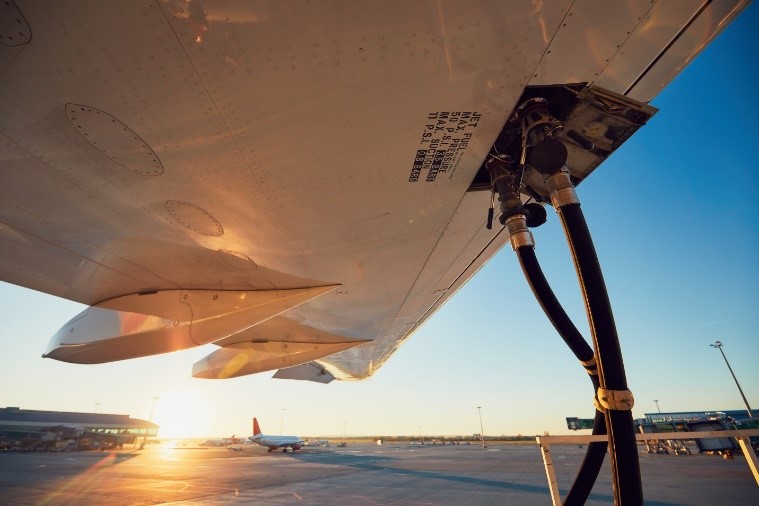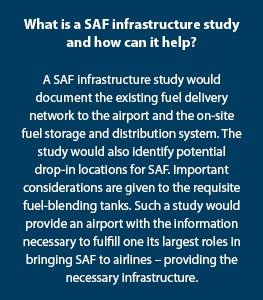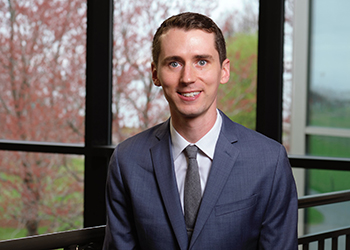Insights: Sustainable Aviation Fuels: What Airports Need to Know
Part two in a two-part series on alternative aircraft fuels. Click here to read the first installment on What Airbus’s Hydrogen Aircraft Means for Airports.

The year 2020 brought many surprises to the aviation industry. One of those surprises was a remarkable decrease in greenhouse gas emissions from air travel. In fact, an article published in Nature Climate Change calculated that global, daily aviation emissions fell by as much as 60% during the height of pandemic related travel restrictions. This figure is remarkable for many reasons, not the least of which is that emissions from air travel have steadily increased in recent years despite global trends towards energy efficiency and renewable energy. That it took a global pandemic to bend the curve is testament to the challenges of decarbonizing this liquid fuel-dependent sector.
Many airports and airlines are exploring ways to rebound from the COVID-19 pandemic without returning to “business as usual” growth of their emissions. Especially as activity returns in earnest, there will be additional attention on the impacts of aviation. Sustainable aviation fuel (SAF) is one possible strategy to help reduce the emissions of the sector.
Sustainable Aviation Fuel 101
SAF is an alternative to conventional petroleum-based jet fuel (Jet-A). SAF can be produced from a number of materials, or feedstocks, ranging from algae, to municipal waste, to agricultural residues. Since many SAF feedstocks are renewable resources, the lifecycle greenhouse gas emissions from burning SAF are typically lower than traditional jet fuel.
SAF is widely seen as one of the nearest term ways to reduce aircraft emissions. Although there is significant momentum towards electric and hydrogen-based propulsion systems, SAF is beneficial because it can be used in any modern turbine aircraft without modifications. SAF is chemically identical to Jet-A, meaning it can serve as a “drop in replacement.” Whereas electric propulsion may meet the needs of short-haul routes, SAF is one of the few currently viable options for reducing emissions from medium- and long-haul flights.
In fact, many aircraft today are already flying on blends of SAF and Jet-A (as of fall 2020, the highest approved ratio is a 50% blend). SAF is currently provided at Los Angeles International and San Francisco International, with additional demonstration flights having taken place at other airports across the country including Chicago O’Hare. The Pacific Northwest has also been a notable leader in the pursuit of SAF, hosting a cross-industry collaborative that continues to evaluate the feasibility of producing, transporting, and using SAF in the region.
Despite this momentum, SAF represents a tiny fraction (far less than 1%) of total jet fuel consumed globally.

Current Challenges
SAF presents several challenges that have limited its adoption to-date:
- COST: As with any new technology, SAF commands a premium over conventional fuel – ranging from three to five times the price (or more) depending on the production method. With airlines seeking to minimize operating costs, the price of SAF will likely be the biggest hurdle to overcome. Although technological improvements will bring the cost down over time, the precipitous drop in oil prices in recent years has made it challenging for SAF to compete.
- PRODUCTION & TRANSPORTATION: Significant private investment in production, refinery, and transport infrastructure will be required to produce SAF at scale and will likely only take place with widespread aviation industry commitments to purchase the fuel. Availability of feedstocks is a critical element and will vary by region.
- AIRPORT INFRASTRUCTURE: Airports have a role to play in the adoption of SAF, including conducting an infrastructure assessment to determine if current fuel assets (e.g., storage and blending tanks, pipelines) are sufficient to accommodate SAF. SAF must meet ASTM standards before and after blending with Jet-A. A forthcoming report from the National Renewable Energy Laboratory will provide additional airport guidance on SAF infrastructure.
Role of Government
The Federal Aviation Administration (FAA) Office of Environment and Energy has supported the development of SAF through a number of industry programs, primarily in the areas of feedstock and production pathways. Additional focus areas have included certification to industry standards, quantifying environmental benefits, costs, and aircraft performance implications, and information coordination and exchange. Although several bills passed by the US House of Representatives in 2020 included SAF provisions, the Senate did not take up any of the bills.
Arguably, the most impactful government action for SAF has taken place at the state level. California’s Low Carbon Fuel Standard (LCFS) has accelerated the adoption of SAF by incentivizing producers to manufacture fuels with lower carbon intensities. This program, and a similar effort in Oregon, has lowered the relative cost of SAF compared to Jet-A.

What Can Airports Do?
Airports are critical stakeholders in making SAF more widely available. If your airport is interested in offering SAF to your airline partners and other operators, the following steps are great starting points:
- Meet with airline representatives and other operators to determine interest level in purchasing SAF.
- Conduct a study to determine whether your current fuel infrastructure is sufficient to handle the blending and storage requirements for SAF, or what upgrades may be necessary.
- Participate in or convene a regional group of stakeholders to evaluate the feasibility of producing and delivering SAF to the airport. Topics that should be assessed include upstream supply chains and distribution networks. A notable example of this stakeholder approach is Sustainable Aviation Fuels Northwest, a regional industry and public sector collaborative centered on expanding the availability of SAF in the Pacific Northwest.
- Encourage state regulators to adopt SAF-favorable legislation, such as a LCFS.

Corey Johnson, CEM, ENV SP
Principal Consultant
To learn more about planning for alternative fuels at your airport, contact Corey at csjohnson@cscos.com.